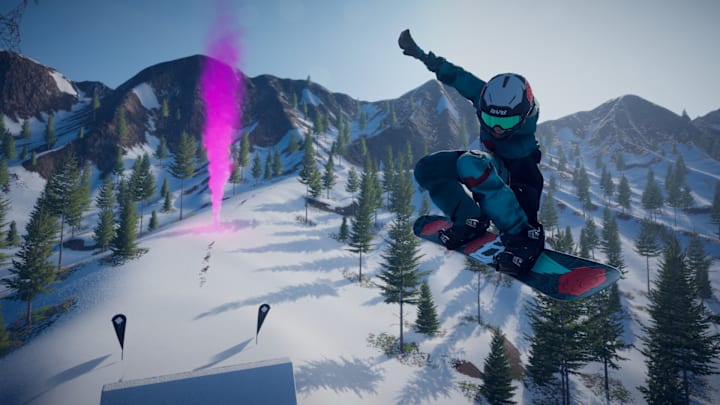Descenders Next early access review: Going downhill fast (in a good way)
By Ryan Woodrow

One easy way to get me hooked on a game is to make movement feel amazing, and that is something that the team behind Descenders has always gotten right. I’ve put more hours than I care to admit into the first game (we’re talking high triple-digit numbers) because I absolutely love how it feels to charge down slopes at speed, gracefully weaving around corners, over obstacles, and occasionally wrapping myself around a tree at Mach 1. It’s hard to put my finger on exactly why I find it so addictive, but it’s a game that I’ll play for 30-60 minutes almost every day because of how satisfying it is to roll down these trails.
I give you all that context so you know how excited I’ve been for Descenders Next, which throws out the BMX in favour of a snowboard and mountainboard, which immediately presents some interesting changes to the gameplay.
On a bike, you have to constantly accelerate to keep your momentum, while on a snowboard, it’s just a bit of effort to get going, and then gravity takes care of the rest – and perhaps most importantly, you don’t have any brakes like you do on a bike. It makes the experience of controlling your momentum very different from the original game.
Before, you’d be holding down the accelerator almost constantly, and the skill came from knowing when to ease up and brake to avoid a horrific accident. Here, it’s a lot harder to slow down, and you instead have to use the analogue sticks to twist your body, which in turn controls the severity of your turns and how you slow down. The left analogue stick is your standard turn, but you can also employ the right analogue stick as you turn to increase the severity, turning the board with you at the same time, coming to a quick stop – that is, as long as you don’t do it too fast and go head over heels.
The fact that you don’t need to constantly be on the accelerator has had consequences on the control scheme too. Where the first game had acceleration on RT/R2, here it’s on A/Cross since you don’t need to use it outside of the start of levels, freeing up the triggers to be used for tricking instead, which is where a bunch more options have been added compared to the first game.
On top of what you had before, where you could use the left analogue stick to back/front flip or perform 360s in mid-air, you can now also use the bumpers to roll sideways, making your combos even more wild than ever, especially when combined with the grab-tricks the triggers offer. It takes a little while to wrap your head around so many options and the full 360 degrees of in-air movement – I spent a lot of time faceplanting into the floor because I overestimated how much time I’d have to complete my rotations – but once you get the hang of it, it’s so satisfying.
All of this is possible on both the snowboard and the mountainboard, and while the two formats are very similar, they aren’t identical. The intricacies of each style of board are different, with the mountainboard’s large wheels giving you a bit more leeway when it comes to risky landings, while only a snowboard lets you grind along rails, as the mountainboard’s wheelbase is too wide.
You get to play with each of these styles in their own biomes – snowy peaks for the snowboard, and the highlands for the mountainboard. In these zones, you navigate through a fixed map of nodes that all take you to levels with varying degrees of steepness, curves, and stunts in them, which is a departure from the first game’s roguelike progression style.
It keeps some elements of it though, like the lives system. You start with four and lose one every time you bail – or two if you have a particularly bad crash, like if you smash your head into a pylon at 100km/h while trying to trick through the gap in the middle, just as a random example that definitely isn’t based on experience, no sir. You make your way from node to node until you find a safe node to bank your progress and cash in your Rep. The more nodes you go without cashing in, the more Rep you’ll earn at the end, but the more likely you are to run out of lives and lose it all.
The game pushes you to play it riskily too. Partly because bigger tricks equal more Rep, but also by giving you an optional objective in every level – things like “do two backflips” or “get five seconds of airtime” – that reward you with additional lives if you succeed. That push and pull keeps every run engaging as you keep trying new things while always being just the slightest mistake away from having your internal organs rearranged by a tree.
Explore enough of the maps and you’ll unlock the “Boss node” for that map, which takes you through the roguelike map style you’ll recognize from the first game, culminating in a massive boss jump that you have to nail to unlock the next biome – though there aren’t yet many of those in this early access version of the game.
It all comes together to make a game that is definitely on the right track. While the lack of roguelike elements might mean I don’t play this game quite as much as I do the original, Descenders Next shows that the series is still the pinnacle of momentum-based gameplay. Going downhill fast has never been so much fun.
More Reviews on DBLTAP:
feed